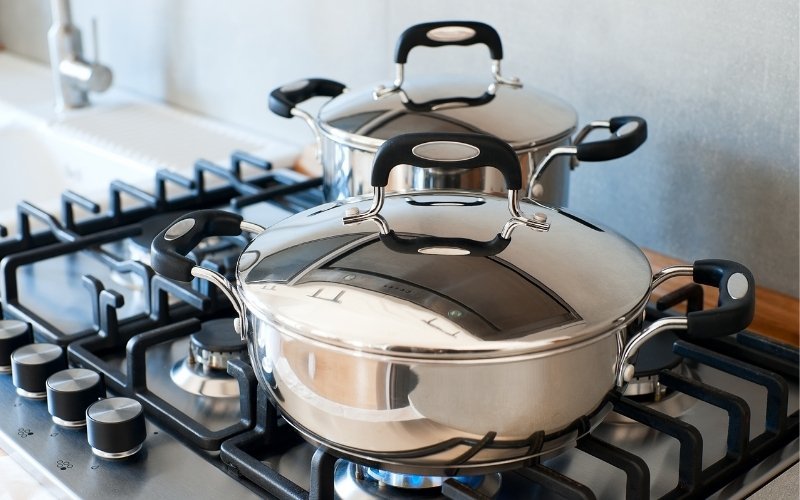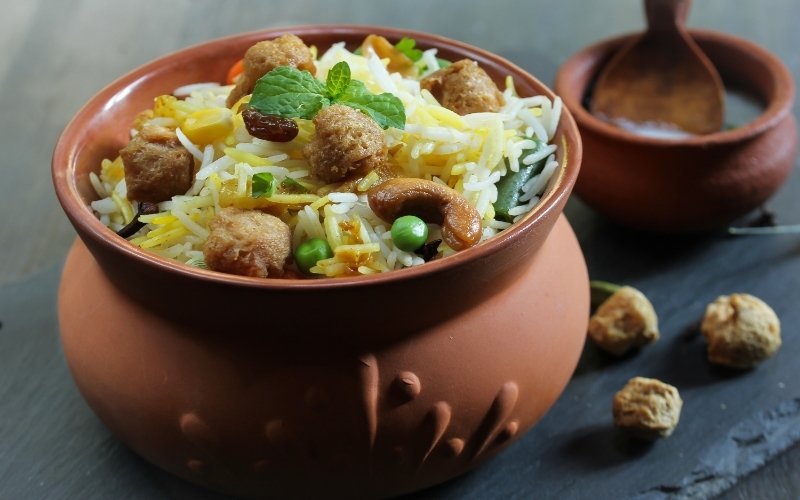Up till a few years back, I predominantly had nonstick cookware in my kitchen. They are easy to use and always clean up quick. Moreover, you can cook with minimal oil. So, what is there not to like?
But soon, we started becoming aware of the ill effects of using nonstick cookware. The fact that it can emit carcinogenic fumes when heated above 260 degrees Celsius was enough to rethink having them in our kitchen. Further, if you have a pet bird, the fumes will cause distress and may even kill them.
Many claim that PTFE used for making nonstick cookware nowadays are safe as long as they are not overheated. PFOA, the real culprit that causes harm is not used in the manufacturing process nowadays.
There is a partial truth to this statement. PFOA does cause harm and it is banned in the US and other western countries.
However, in India, the cookware manufacturing process is largely unregulated. You have to take the manufacturer’s word that their products are PFOA free. Further, a lot of other chemicals which belong to the same class as PFOA is used in the manufacturing process. There is a lack of transparency and we consumers have no clue whether they are actually safe. And often it is found that sewage in industrial areas have PFOA presence.
Nonstick pans are also called as Teflon pans. But, actually, Teflon is the brand owned by Chemours. The nonstick coating they use is made of PTFE. Just like how Xerox became equivalent of photocopy, Teflon has become a synonym of PTFE.
An often-asked question is whether ceramic coated cookware are safe? The ceramic coating is made by a process called Sol-Gel whereby an inorganic compound is made in a gel-like form, which makes it easy to coat it over a metal.
Here Silicon Dioxide ( sand) is used, which is a safe compound. It is highly heat resistant and doesn’t emit harmful chemicals. But, if strict safety standards are not followed, it could be contaminated with lead, cadmium and such heavy metals, which could leach into your food. So, you need to be sure to buy from reputed brands that use ceramic coating from the EU which has stringent safety standards. Even then, you can’t be 100% sure as these industries are unregulated in India.
So, it is prudent to discard those nonstick pans from your kitchen and resort to safer alternatives. So, which are the safer alternatives? Let us explore.
Related reading: 10 Essential Cookware You Should Have In Your Kitchen
Best Safe and Healthy Cookware In India
Cast Iron Cookware

Cast iron is an alloy of iron that contains 2-3% carbon with minor quantities of silicon, manganese and impurities such as sulphur and phosphorous.
The molten alloy is poured into a cast made of sand and then cooled down. After smoothening the surface, a layer of oil with high-fat content is applied and then the cookware is heated in a kiln to season it.
The main advantage of cast iron cookware is its excellent heat retention. If you heat it up to a scorching temperature and then drop a fish or chicken, the pan still retains the high temperature. This ensures excellent browning.
In fact, when I cook poriyal in my cast iron Kadai, I half-cook the vegetables and switch off the flame. The heat retained by the Kadai slowly cooks the vegetables completely. It helps save fuel and also preserves the flavour and nutrients.
Most people complain that cast iron cookware rust quickly and that they are hard to maintain. And that is true- they are prone to rust. But, you just need to spend 2-3 minutes every day to prevent that.
After cooking in your cast iron cookware, clean it with soap and scrub. Yes, you can use soap on it. It doesn’t affect the seasoning or the cast iron’s quality in any way. Then, dry the cookware by heating it on the stovetop and apply a thin layer of oil.
To season the cookware, apply a thin layer of oil. Dab off any excess oil with a cloth or tissue. Then heat it on a high flame till the oil starts smoking. If you don’t dab off the excess oil, the pan with have a gummy texture after heating. A well-seasoned cast-iron pan is next to Teflon pan in terms of stick resistance.
Check our article on Best Cast Iron Cookware in India to know top recommendations.
Related reading:
How to season cast iron cookware on stovetop
Health Benefits of Cast Iron: Myths and Facts
Best Cast Iron Dosa Tawa In India
Stainless Steel Cookware

Different grades of stainless steel cookware are available in the market. The cheaper varieties are single-ply stainless steel with a thick disc bottom. They have a tendency to scorch food around the edges. Also, they are not quite durable as the disc bottom may come off after a few years of use.
The expensive variety, triply stainless steel, is made of 2 layers of stainless steel with a layer of aluminium sandwiched in between. The stainless steel is 304 grade- 18/8 or 18/10. Here, 18 refers to chromium percentage and 8/10 refers to nickel percentage.
Stainless steel, as such, is a bad conductor of heat. This is why a layer of aluminium is sandwiched between stainless steel. It conducts heat better and prevents any hot spots.
Chromium and nickel in stainless steel cookware may leach into food, especially so, if you cook acidic food with tomatoes and lime for more than 2 hours. But in normal conditions, it leaches nickel below allergy-triggering thresholds. So unless you have an allergy to nickel, you needn’t avoid stainless steel.
Out of the options of 3 ply stainless steel cookware available in the market, reliable ones are Bergner, Stahl, Vinod, Meyer, Borosil, Prestige and Hawkins.
Check out our article on Best Stainless Steel Cookware to know our top recommendations.
You may also like our article on Best Air Fryers In India
Clay Pots

Clay pots have been used from time immemorial for cooking. Being made of clay, they are porous and retain temperature for a long. Also, it absorbs moisture and circulates it within the food. So fish and meat cooked in a clay pot are succulent. As clay pot heat slowly, minimal nutrients are lost while cooking too.
But, not all clay pots are made equal. It is better to opt for unglazed pots as they are more porous. The chemicals used for glazing may contain harmful elements like lead and mercury which could leach into your food. Even unglazed pots should be immersed in water for 2-3 hours and then scrubbed thoroughly to remove any impurities.
A question often asked is about the difference between brown and black clay pots. Brown pots are heated for 3-4 days in the kiln and burnt to give it a black colour. The impurities in it are burnt off. Black pots are generally stronger and more durable than brown pots.
Compared to stainless steel, cast iron and carbon steel, clay pots are a better option for cooking acidic food.
The best place to buy clay pots is from your local market. These artisans need your support.
If you want to buy online, you could check out options from Tribal Culture or Craftsman India.
Carbon Steel Cookware

Carbon steel combines the goodness of cast iron with nonstick. It is lightweight, and acts as a non-stick when seasoned correctly. They are slowly gaining popularity in India.
It typically contains 99% iron and 1% carbon. So, just like cast iron, it is prone to rust if not seasoned correctly. The seasoning process is just like how you do it for cast iron.
Due to the lower percentage of carbon, carbon steel is more pliable and can be made thinner and lighter.
Compared to cast iron, carbon steel heats up more quickly. Hence, it doesn’t have many hot spots. It retains heat fairly well, but is not as good as a cast iron.
A drawback however is that you can’t cook anything acidic in it, as it strips off the seasoning.
